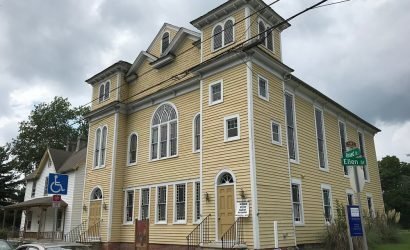Harriet Tubman was known as ‘the Moses of her people’. She found freedom for herself and some three-hundred other slaves whom she led north to safe lands. In the Civil War she served the Union Army as a nurse, scout, and a spy… and she was born and raised on the Eastern Shore of Maryland.
.JPG)
|
Exhibitions orient visitors to Harriet Tubman and Dorchester County's role in the Underground Railroad. The Dorchester County Visitor Center at Sailwinds Park provides information about the region's natural and cultural history, tourist attractions, and amenities. The Center is open daily from 8:30 am – 5 pm. |
 |
The Harriet Tubman Organization mantains this non-profit educational and information center and gift shop. The Center offers literature, historical information, a video presentation, and specialized tours about Harriet Tubman. |
 |
Next to the Harriet Tubman Museum and Education Center is a courtyard. An expansive, eye-catching mult-material mural depicts some of Cambridge's most memorable history and aspects of daily life in Dorchester County. |
 |
The Old Trinity Church was built in the 17th century and was restored in the 1950’s. Since then, the building has deteriorated and is currently condemned. This architectural building housed an active congregation of the Episcopal Church. The church is located on Route 16 in Church Creek – just 5 miles from the Blackwater National Wildlife Refuge. |
 |
The Stanley Institue is the oldest community-owned one-room schoolhouse still intact in Dorchester County. The building was first constructed circa 1865 near Church Creek. The building was moved to its current location in 1867. It was used continuously until July 15, 1966. This building may have been used as a resting point for Tubman and those on the Underground Railroad. (Photo of historic Stanley Institute.) |
|
|
Ben Ross, Harriet Tubman's father, probably lived near Harrisville Road on Anthony Thompson's plantation from the early 1800s until about 1847. Ross marriet Harriet Rit Green who belonged to Thompson's stepson, Edward Brodess. Ross served as a head timber cutter for Thompson and his son, Dr. Anthony C. Thompson, and spent much of his time in the wooded area. (Photo of church on Harrisville Road with wooded area behind.) After Brodess reached adulthood in 1823, he moved to a farm in Buckton and took Green and her 5 oldest children, including Harriet, with him. By 1840, both Ross and Green were living on Thompson's farm, where they presumably stayed until about 1847 when they moved to Poplar Neck in Caroline County. Some of their children remained in this area and were hired out by Brodess to local landowners. |
 |
Before the Civil War, Whitehaven and Church Creek served as a major shipbuilding center that employed black and white workers. The town is located on a tract called Whitehaven, settled in the 17th century by an ancestor of Anthony Thompson. In 1860, local resident Charles Dixon was indicted in the Dorchester County Court for circulating a copy of Impending Crisis, an abolitionist book. (Photo of Church Creek/Whitehaven.) |
 |
The Stewart family owned substantial property and operated numerous businesses in the area. Joseph Steward designed a canal to float cut logs to his shipyard on the west side of Madison Bay. Enslaved African Americans dug the 6 – 7 mile canal through the marsh by hand from 1810 into the 1830's. (Photo shows a small part of the canal dug that leads to the shipyard.) Harriet Tubman learned important survival skills when she and her father worked in the Stewart family timbering operations in this area. In Madison she may have met the slaved shipbuilders and sailors who provided information about the north and how to navigate by the stars, a skill Tubman supposedly used when guiding passengers along the Underground Railroad routes. |
 |
The Blackwater National Wildlife Refuge is a 27,000-acre area that contains wetlands and forests similar to those of the mid-19th century. The refuge lines the Big Blackwater River and its major northern branches, the Little Blackwater and Transwuaking Rivers. These wetlands provided protection to freedom seekers who followed the rivers northward and hid in the forests and marshes. Those who hid in the marshes foraged for food and struggled through murky, cold, deep water to throw pursuers off their trail. |
 |
The Oak Grove Methodist Church stands along Smithville Road between Taylors and Hoopers Islands. The historic chapel was built in 1874. The church is hidden in a forest of tall oak trees and loblolly pines. The gothic-revival style church is a southern church with an entirely African American denomination. |









